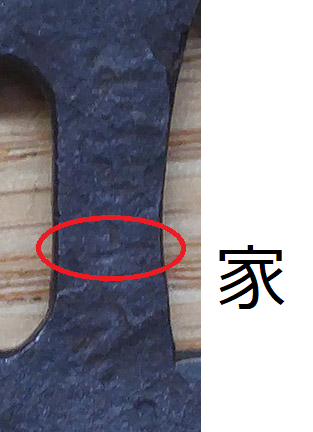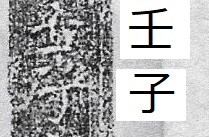-
Posts
4,268 -
Joined
-
Last visited
-
Days Won
96
Content Type
Profiles
Forums
Events
Store
Downloads
Gallery
Everything posted by SteveM
-
I should say that my confidence level on this is an unreassuring 50/50. I'm not finding a lot of two-kanji Kunisadas that could fit the bill. Masamune... also a possibility.
-
国定 Kunisada would be my guess.
-
江府住 正芳 Kōfu jū Masayoshi The first part, Kōfu jū means "resident of Edo", the second part is his name, Masa-something. I cannot read the second kanji of his name. It vaguely looks like 芳 (yoshi), but I do not have great confidence in that guess, primarily because of the several smiths who used the art name Masayoshi, none of them signed as "Resident of Edo". Which means my reading is wrong (likely), or it is a signature that is so unique it hasn't made it into the reference books (unlikely, but it happens).
-
↑ Interesting. I was going to say 家 for the second kanji, which leads to the possibility of 金家 (Kaneie).
-

Japanese Language Knowledge Asked
SteveM replied to matchlockshooter's topic in Translation Assistance
五分三厘筒 5 bu 3 rin = something like 18 mm. -

Echizen No Kami Sukehiro Mei Question
SteveM replied to Surfson's topic in General Nihonto Related Discussion
The "suke" looks fine to me. The mei overall looks OK to me. But if you have no pictures of the sword itself, its a bit of a non-starter. -
中原 Nakahara
-

Help With Sukemune Ura (Date) Translation
SteveM replied to Ron STL's topic in Translation Assistance
壬子 (Mizunoe-ne) is the zodiac year, and in this case it verifies the date of Kaei 5. It is common for the zodiac year to follow the nengo date. So if the two kanji following the nengo date look like a zodiac year, and if it looks like a zodiac year that corresponds to the nengo year, you can be confident that the two confirm each other. In your friend's yari, the 子 looks a bit like 序 due to the slanting horizontal line on the left, but I'm sure this is an effect of the metal or the rubbing, and is not part of the kanji -
Hello Lokomilo (I should point out that one of the rules of this forum is to sign with a real first and/or last name), The smith in your post number 8 provides an important clue. The father, whose birth name was apparently Takai Sadajirō (高井貞次郎) , used the art name Sadatsugu (貞継), keeping one kanji from his real name and using it in his art name. The son continued the tradition of using that same character in his own art name - Sadahiro (貞弘). So both father and son used "Sada" in their art names. Again, for some reason which we will probably never know, the son also signed as Igami Sadahiro (伊神貞弘) . We don't know why exactly he decided to adopt a new family name for his art name, however this is not unusual in the Japanese world of arts. Also note that it is not unusual for an art name to undergo several changes throughout the artist's life. In the case of your sword, Sadahiro has fused part of his real family name (井) with part of his adopted name of Igami (伊神→井神). Note that both 伊 and 井 are pronounced the same. Maybe he used 井 as an homage to the real family name, or in further homage to his father, or maybe he was just trying out a different style of art name to see if he liked it. Whatever the reason, I think you can be 100% confident that your signature belongs to the artist born as Takai Shirō, and who is known by the art name of Sadahiro. Hopefully this makes it a bit more clear. And, apologies if I accidentally made it more confusing.
-
Perhaps it (井) was a kanji character that was used in the name of a mentor or a smith who tutored Igami, and so he adopted it as an homage. Perhaps there was another reason. Also, it is entirely possible that I could be mistaken, and that this is just a forgery or an unknown smith. However the idea that someone would be motivated to forge this particular smith, with this unusual spelling, on a WW2 sword seems far-fetched to me. And the engraving does look very characteristic of the chippy WW2 engravings, so despite having a nagging question-mark surrounding that particular kanji, it does look authentic.
-
Hello Jesper, The title is Bansei Bukan 萬世武鑑, which loosely translates as "Encyclopedia Militaria", published and printed in several editions between 1846 and 1869. I will put some links to the references I found. http://toshoryo.kunaicho.go.jp/Kotenseki/Detail/24324?Mode=0&FreewordOp=0&SortRule=0&LinesPerPage=50&PagiNation=844 http://www.library.pref.kagoshima.jp/honkan/files/2011/05/058_%E8%96%A9%E8%97%A9%E6%AD%A6%E9%91%91%E6%B5%B7%E6%B1%9F%E7%94%B0%E4%BF%A1%E7%BE%A9%E6%96%87%E6%9B%B8.pdf https://trc-adeac.trc.co.jp/WJ11E0/WJJS06U/2321315100/2321315100100010?hid=ht116090
-
井神貞弘 Igami Sadahiro The one problem you are stuck with is that there is no known smith with this exact name, however there is a tantalizingly close Igami Shirō (伊神四郎), who used the name 貞弘 Sadahiro. Based on the lack of any evidence of another swordsmith with this name, and the unusually similar last names combined with Sadahiro, I think its safe to assume that 伊神四郎 is your man, and for some reason he used an alternative spelling on this sword.
-

Help With Sukemune Ura (Date) Translation
SteveM replied to Ron STL's topic in Translation Assistance
嘉永五壬子年 I am thinking the final part is a name 囗前勝透 ?-mae Katsuyuki -
-
Hello Aldwin, The mei is 伯耆守藤原汎隆 Hōki-no-kami Fujiwara Hirotaka. You came very close. In fact, you could have plugged what you had written into a search engine, and one of the first hits would have lead you to the swordsmith you are looking for The other side is a tameshi mei (saidan mei), by Matsunami Tokiemon (松波時右衛門 - which you can see bits of on the bottom). It is a known name, and the first 4 characters of the name are distinct. I cannot figure out the above part due to wear and rust. It will be a description of which kind of test cut was made. It could be 雁金?落ち切り?
-
福本兼宗 Fukumoto Kanemune
-

A Little Help? Nengo And Special Order
SteveM replied to SwordGuyJoe's topic in Translation Assistance
I was thinking the same thing... this guy loved having Shigemasa make swords for him. -

A Little Help? Nengo And Special Order
SteveM replied to SwordGuyJoe's topic in Translation Assistance
Check out the following thread (started by some guy named Joe ), which has a couple of similar signatures, (corroborating what Matt says above). http://www.militaria.co.za/nmb/topic/14967-custom-order-translation/ -
The second set of photos helped a lot. February 1942, for sure.
-
I think the date is 1942 昭和十七年二月 Shōwa 17 (1942) February The angle of the photo puts the two characters in blue in a bit of a dead spot, where the relief of the engraving gets lost in the rough texture of the steel. A different angle might remove all doubt as to those two characters.
-

Wwii Japanese Type 95 Nco Sword, $600 Obo
SteveM replied to emilyhsaylor's topic in For Sale or Trade
I think this is a very admirable sentiment. We are only temporary caretakers of these things. Best to pass them along to those who have an interest in them and can care for them. -
I wondered if it might be 大袈裟 ōgesa (a type of tameshigiri cut), but it seems to require too much wishful thinking on my part. I'm afraid I can't offer much else.
-

"made From Old Hoe" Inscription Sword?
SteveM replied to Vermithrax16's topic in General Nihonto Related Discussion
Search for a smith called Nagayuki. Markus Sesko has mentioned this type of inscription before (eg. 長幸以古鍬作之) -
Love it! Morita-san to the rescue again.
-
Not a clue, but I'm dying to know what it says. 光(支?)甫淥状附 I would expect a swordsmith, region, description, date, or something that I could grab a hold of, but nothing in these 5 kanji give me any clue. They look like they were written by somebody who knows how to write well.





